🥶AP Biology Chapter 11: Mendel and the Gene Idea
Introduction
11.1 Mendel used the scientific approach to identify two laws of inheritance
11.2 Probability laws govern Mendelian inheritance
11.3 Inheritance patterns are often more complex than predicted by simple Mendelian genetics
11.4 Many human traits follow Mendelian patterns of inheritance
BIG IDEAS: The meticulous work of Mendel and others in the 19th century provided evidence for a particulate mechanism of inheritance that led to our current understanding of the chromosomal basis of the inheritance of genes from parent to offspring (Big Idea 3) and provided structural and functional evidence to support the relatedness of all domains (Big Idea 1)
%%Why was Mendel’s choice of pea plants as an experimental organism so fortuitous in developing a model of inheritance?%%
{{“Blending” Hypothesis:{{
The idea that genetic material contributed by the two parents mixes, just as blue and yellow paints blend to make green. This hypothesis predicts that over many generations a freely mating population will give rise to a uniform population of individuals—something we don’t see. The blending hypothesis also fails to explain how traits can reappear after skipping a generation
{{“Particulate“ Hypothesis:{{
Parents pass on discrete heritable units—genes—that retain their separate identities in offspring. An organism’s collection of genes is more like a deck of cards than a bucket of paint. Like cards, genes can be shuffled and passed along, generation after generation, in undiluted form
Figure 11.1: What principles of inheritance did Gregor Mendel discover by breeding pea plants?

%%Concept 11.1: Mendel used the scientific approach to identify two laws of inheritance%%
Gregor Mendel formulated a theory of inheritance based on experiments with garden peas, proposing that parents pass on to their offspring discrete genes that retain their identity through generations. This theory includes two “laws.”
The law of segregation states that genes have alternative forms or alleles. In a diploid organism, the two alleles of a gene segregate (separate) during meiosis and gamete formation; each sperm or egg carries only one allele of each pair. This law explains the 3:1 ratio of F2 phenotypes observed when monohybrids self-pollinate. Each organism inherits one allele for each gene from each parent. In heterozygotes, the two alleles are different: expression of the dominant allele masks the phenotypic effect of the recessive allele. Homozygotes have identical alleles of a given gene and are true-breeding.
The law of independent assortment states that the pair of alleles for a given gene segregates into gametes independently of the pair of alleles for any other gene. In a cross between dihybrids (individuals heterozygous for two genes), the offspring have four phenotypes in a 9:3:3:1 ratio.
\n
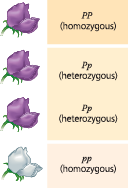
Reasons why Mendel chose to work with peas
They are available in many varieties and Mendel could strictly control mating between plants
{{Character:{{
An observable heritable feature that may vary among individuals
{{Trait:{{
One of two or more detectable variants in a genetic character
{{Stamens:{{
Pollen-producing organs in each pea flower
{{Carpel:{{
An egg-bearing organ in each pea flower
Since pea plants usually self-fertilize, Mendel ___ to produce _
- removed the immature stamens of a plant before they produced pollen and then dusted pollen from another plant onto the altered flowers; zygotes
Technique:
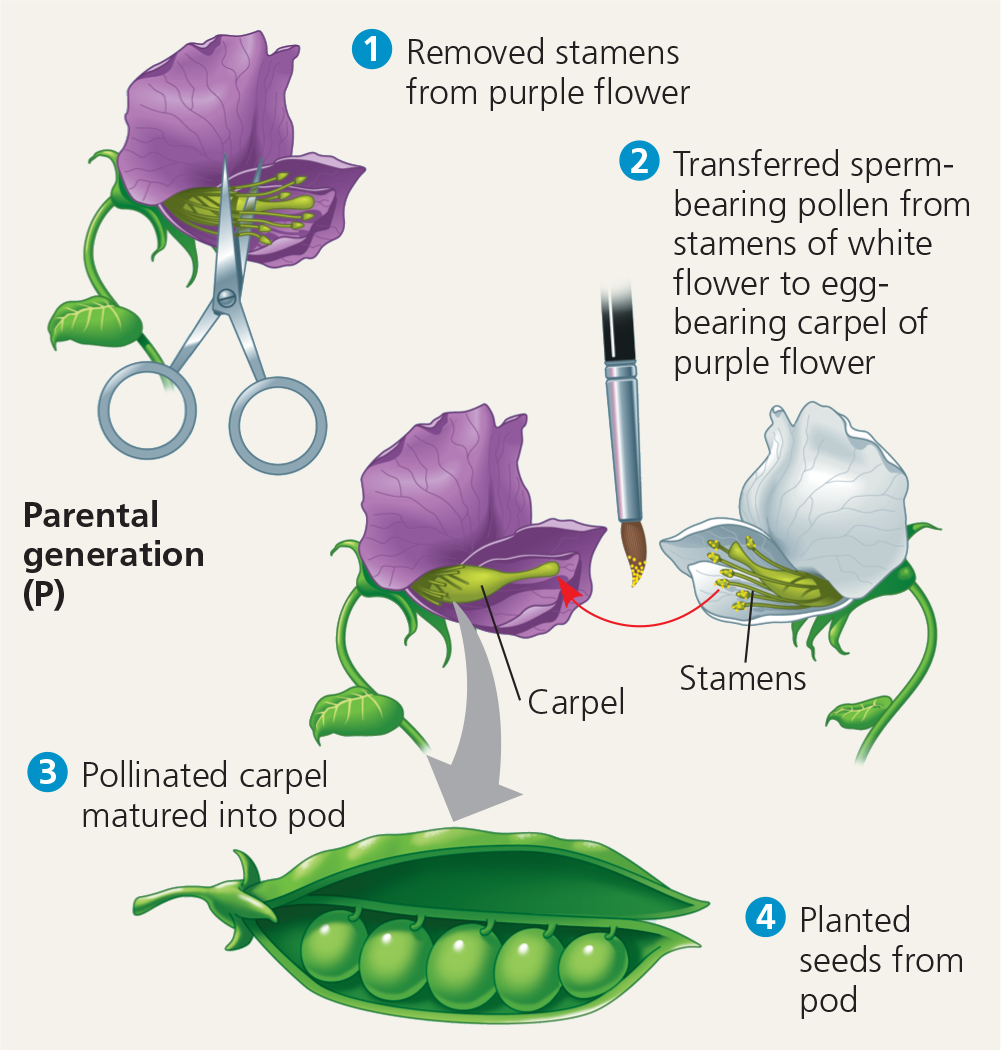
Results: When pollen from a white flower was transferred to a purple flower, the first-generation hybrids all had purple flowers. The result was the same for the reciprocal cross, which involved the transfer of pollen from purple flowers to white flowers

{{True-Breeding:{{
Referring to organisms that produce offspring of the same variety over many generations of self-pollination
{{Hybridization:{{
In genetics, the mating, or crossing, of two true-breeding varieties
{{P Generation:{{
The true-breeding (homozygous) parent individuals from which F1 hybrid offspring are derived in studies of inheritance; “parental“ generation
{{Homozygous:{{
The presence of two identical alleles at a particular gene locus; true-breeding
{{F1 Generation:{{
Hybrid (heterozygous) offspring arising from a parental (P generation) cross; “first filial“ generation
{{Heterozygous:{{
Having inherited different versions (alleles) of a genomic marker from each biological parent
{{F2 Generation:{{
The offspring resulting from interbreeding or self-pollination of the hybrid F1 generation; “second filial“ generation
Mendel’s quantitative analysis of the F2 plants from thousands of genetic crosses like these allowed him to deduce ___
- the law of segregation and the law of independent assortment
Why doesn't the experiment support the blending model?
If the blending model of inheritance were correct, the F1 hybrids from a cross between purple-flowered and white-flowered pea plants would have pale purple flowers, a trait intermediate between those of the P generation
What happened between F1 and F2 of Mendel’s experiment?
All the F1 offspring had flowers of the same color as the purple-flowered parents. But when Mendel allowed the F1 plants to self-pollinate and planted their seeds, the white-flower trait reappeared in the F2 generation
How does this support the particulate hypothesis?
If the white-flowered plants’ genetic contributions were lost, then the F1 plants could produce only purple-flowered offspring in the F2 generation. However, it reappeared.
What was the flower ratio?
3 purple to 1 white
{{Dominant Trait:{{
A trait seen when two different alleles for a gene are present but one allele overpowers or masks the existence of the other
{{Recessive Trait:{{
A trait seen when a gene’s effects are masked in the presence of a dominant gene
{{Heritable Factor:{{
Traits encoded in DNA that are passed through generations
Experiment: Mendel crossed true-breeding purple-flowered plants and white-flowered plants (crosses are symbolized by ×). The resulting F1 hybrids were allowed to self-pollinate or were cross-pollinated with other F1 hybrids. The F2 generation plants were then observed for flower color
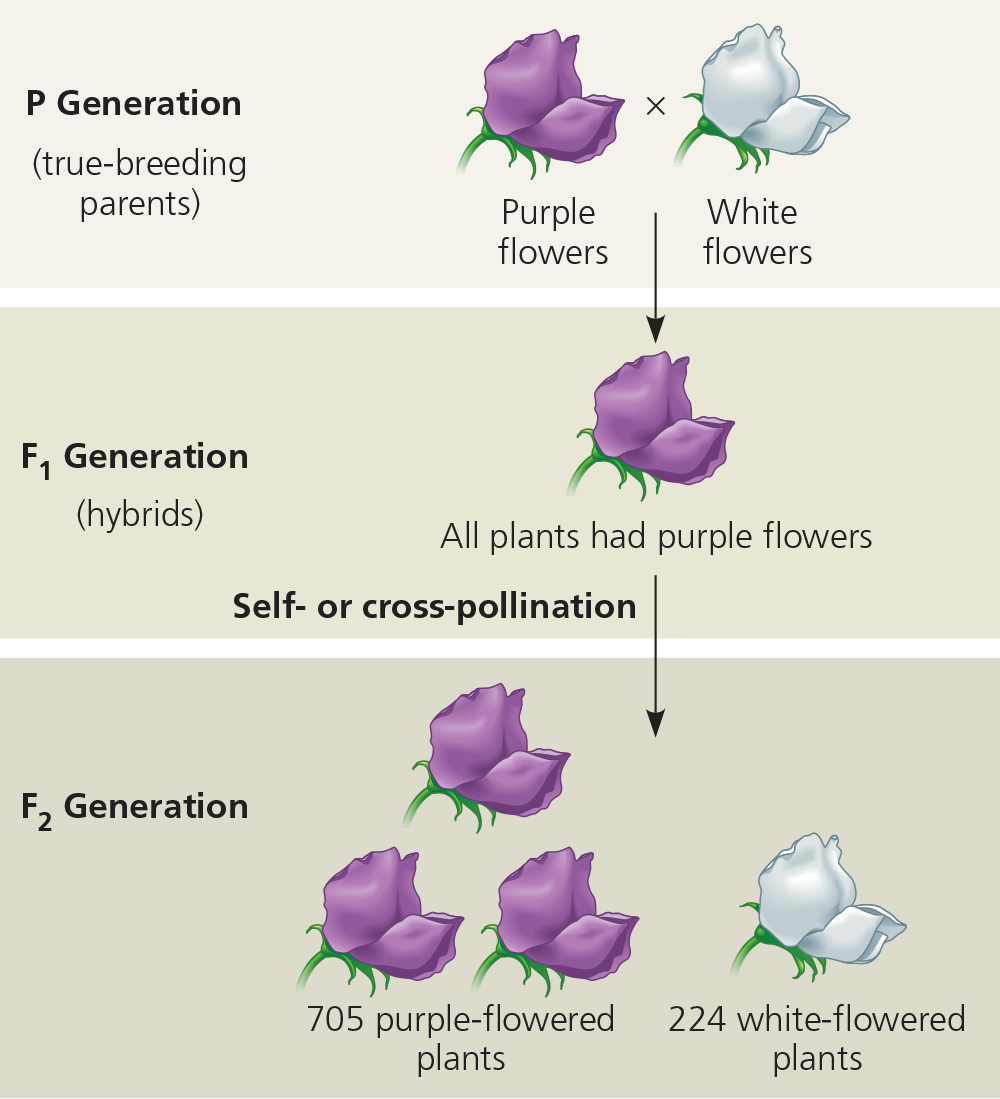
Results:
Both purple-flowered and white-flowered plants appeared in the F2 generation, in a ratio of approximately 3:1
Conclusion:
The “heritable factor” for the recessive trait (white flowers) had not been destroyed, deleted, or “blended” in the F1 generation but was merely masked by the presence of the factor for purple flowers, which is the dominant trait
If you mated two purple-flowered plants from the P generation, what ratio of traits would you expect to observe in the offspring? Explain
All offspring would have purple flowers. (The ratio would be 1 purple : 0 white.) The P generation plants are true-breeding, so mating two purple-flowered plants produce the same result as self-pollination: All the offspring have the same trait
The Results of Mendel’s F1 Crosses for Seven Characters in Pea Plants
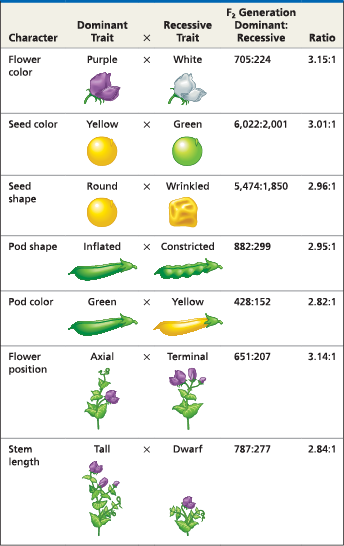
{{Alternative versions of genes account for variations in inherited characters:{{
The purple-flower allele and the white-flower allele are two DNA sequence variations possible at the flower-color locus on one of a pea plant’s chromosomes. The purple-flower allele sequence allows the synthesis of purple pigment, and the white-flower allele sequence does not
{{Alleles:{{
Any of the alternative version of a gene that may produce distinguishable phenotypic effects
Alleles, alternative versions of a gene: This diagram shows a pair of homologous chromosomes in an F1 hybrid pea plant, with the actual DNA sequence from the flower color allele of each chromosome. The paternally inherited chromosome (blue) has an allele for purple flowers, which codes for a protein that indirectly controls the synthesis of purple pigment. The maternally inherited chromosome (red) has an allele for white flowers, which results in no functional protein being made
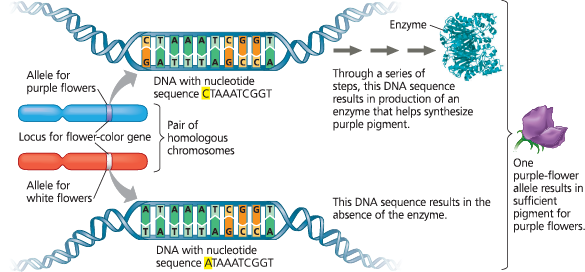
{{For each character, an organism inherits two copies (that is, two alleles) of a gene, one from each parent:{{
Each somatic cell in a diploid organism has two sets of chromosomes, one set inherited from each parent. The two alleles at a particular locus may be identical, as in the true-breeding plants of Mendel’s P generation, or the alleles may differ, as in the F1 hybrids
{{If the two alleles at a locus differ, then one, the dominant allele, determines the organism’s appearance; the other, the recessive allele, has no noticeable effect on the organism’s appearance:{{
Mendel’s F1 plants had purple flowers because the allele for that trait is dominant and the allele for white flowers is recessive
{{Dominant Allele:{{
An allele that is fully expressed in the phenotype of a heterozygote
{{Recessive Allele:{{
An allele whose phenotype effect is not observed in a heterozygote
{{Law of Segregation:{{
Mendel’s first law; the two alleles in a pair segregate (separate from each other) into different gametes during gamete formation
{{The two alleles for a heritable character segregate (separate from each other) during gamete formation and end up in different gametes:{{
An egg or a sperm gets only one of the two alleles that are present in the somatic cells of the organism making the gamete. If different alleles are present, as in the F1 hybrids, then 50% of the gametes receive the dominant allele and 50% receive the recessive allele
{{Punnett Square:{{
A diagram used in the study of inheritance to show the predicted genotypic results of random fertilization in genetic crosses between individuals of known genotype
Mendel’s law of segregation: This diagram shows the genetic makeup of the generations in Figure 11.3. It illustrates Mendel’s model for the inheritance of the alleles of a single gene. Each plant has two alleles for the gene-controlling flower color, one allele inherited from each of the plant’s parents. To construct a Punnett square that predicts the F2 generation offspring, we list all the possible gametes from one parent (here, the F1 female) along the left side of the square and all the possible gametes from the other parent (here, the F1 male) along the top. The boxes represent the offspring resulting from all the possible unions of male and female gametes

{{Homozygote:{{
An organism that has a pair of identical alleles for a gene (encoding a character)
{{Heterozygote:{{
An organism that has two different alleles in a gene
{{Phenotype:{{
The observable physical and physiological traits of an organism, which are determined by its genetic makeup
{{Genotype:{{
The genetic makeup, or set of alleles, of an organism
What type of trait is self-pollination?
Phenotypic trait
Phenotype versus genotype: Grouping F2 offspring from a cross for flower color according to phenotype results in the typical 3:1 phenotypic ratio. In terms of genotype, however, there are actually two categories of purple-flowered plants, PP (homozygous) and Pp (heterozygous), giving a 1:2:1 genotypic ratio
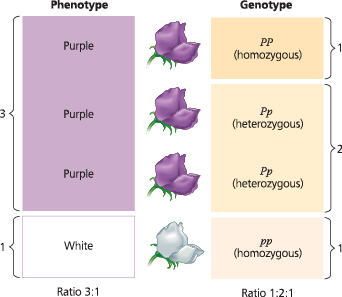
{{Testcross:{{
Breeding an organism of an unknown genotype with a homozygous recessive individual to determine the unknown genotype.
The ___ in the offspring reveals the unknown genotype.
- ratio of phenotypes
Testcross Technique

Testcross Results

{{Monohybrids:{{
An organism that is heterozygous with respect to a single gene of interest. For example, parents AA and aa produce a monohybrid of genotype Aa.
All of the offspring from a cross between parents homozygous for different alleles are ___
- monohybrids
{{Monohybrid Cross:{{
A cross between two organisms that are heterozygous for the character being followed (or the self-pollination of a heterozygous plant)
{{Dihybrids:{{
An organism that is heterozygous with respect to two genes of interest. AABB and aabb produce genotype AaBb
All the offspring from a cross between parents doubly homozygous for different alleles are ___
- dihybrids
{{Dihybrid Cross:{{
A cross between two organisms that are each heterozygous for both of the characters being followed (or the self-pollination of a plant that is heterozygous for both characters)
Experiment: To follow the characters of seed color and seed shape through the F2 generation, Mendel crossed a true-breeding plant with yellow round seeds with a true-breeding plant with green wrinkled seeds, producing dihybrid F1 plants. Self-pollination of the F1 dihybrids produced the F2 generation. The two hypotheses (dependent and independent “assortment” of the two genes) predict different phenotypic ratios

Results

Conclusion
Only the hypothesis of independent assortment predicts two of the observed phenotypes: green round seeds and yellow wrinkled seeds (see the right-hand Punnett square). The alleles for each gene segregate independently of those of the other, and the two genes are said to assort independently
Suppose Mendel had transferred pollen from an F1 plant to the carpel of a plant that was homozygous recessive for both genes. Set up the cross and draw Punnett squares that predict the offspring for both hypotheses. Would this cross have supported the hypothesis of independent assortment equally well?
Yes, this cross would also have allowed Mendel to make different predictions for the two hypotheses, thereby allowing him to distinguish the correct one

The alternative hypothesis is that the two pairs of alleles segregate ___
- independently of each other
{{Law of Independent Assortment:{{
Mendel’s second law, stating that each pair of alleles segregates, or assorts, independently of each other pair during gamete formation; applies when genes for two characters are located on different pairs of homologous chromosomes or when they are far enough apart on the same chromosome to behave as though they are on different chromosomes
Pea plants heterozygous for flower position and stem length (AaTt) are allowed to self-pollinate, and 400 of the resulting seeds are planted. Draw a Punnett square for this cross. How many offspring would be predicted to have terminal flowers and be dwarf?
According to the law of independent assortment, 25 plants (1/16 of the offspring) are predicted to be aatt, or recessive for both characters. The actual result is likely to differ slightly from this value
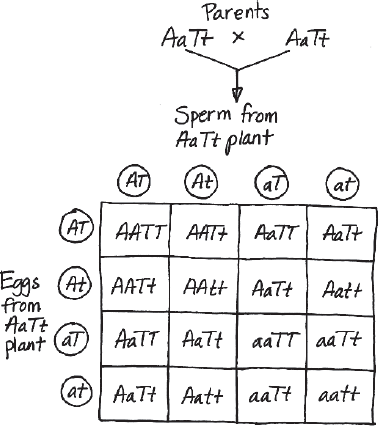
List all gametes that could be made by a pea plant heterozygous for seed color, seed shape, and pod shape (YyRrIi; see Table 11.1). How large a Punnett square is needed to predict the offspring of self-pollination of this “trihybrid”?
The plant could make eight different gametes (YRI, YRi, YrI, Yri, yRI, yRi, yrI, and yri). To fit all the possible gametes in a self-pollination, a Punnett square would need 8 rows and 8 columns. It would have spaces for the 64 possible unions of gametes in the offspring
In some pea plant crosses, the plants are self-pollinated. Explain whether self-pollination is considered asexual or sexual reproduction
Self-pollination is sexual reproduction because meiosis is involved in forming gametes, which unite during fertilization. As a result, the offspring in self-pollination are genetically different from the parent
When Mendel did crosses of true-breeding purple- and white-flowered pea plants, the white-flowered trait disappeared from the F1 generation but reappeared in the F2 generation. Use genetic terms to explain why that happened
Alternative versions of genes, called alleles, are passed from parent to offspring during sexual reproduction. In a cross between purple- and white-flowered homozygous parents, the F1 offspring are all heterozygous, each inheriting a purple allele from one parent and a white allele from the other. Because the purple allele is dominant, it determines the phenotype of the F1 offspring to be purple, and the expression of the recessive white allele is masked. Only in the F2 generation is it possible for a white allele to exist in the homozygous state, which causes the white trait to be expressed
%%Concept 11.2: Probability laws govern Mendelian inheritance%%
The multiplication rule states that the probability of two or more events occurring together is equal to the product of the individual probabilities of the independent single events. The addition rule states that the probability of an event that can occur in two or more independent, mutually exclusive ways is the sum of the individual probabilities.
The rules of probability can be used to solve complex genetic problems. A dihybrid or other multicharacter cross is equivalent to two or more independent monohybrid crosses occurring simultaneously. In calculating the chances of the various offspring genotypes from such crosses, each character is first considered separately and then the individual probabilities are multiplied
{{Multiplication Rule:{{
A rule of probability stating that the probability of two or more independent events occurring together can be determined by multiplying their individual probabilities
By the multiplication rule, then, the probability that both coins will land heads up is ___
- ½ × ½ = ¼
Segregation of alleles and fertilization as chance events: When a heterozygote (Rr) forms gametes, whether a particular gamete ends up with an R or an r is like the toss of a coin. We can determine the probability for any genotype among the offspring of two heterozygotes by multiplying together the individual probabilities of an egg and sperm having a particular allele (R or r in this example)

That is, F1 gametes can combine to produce Rr offspring in two ___ ways: For any particular heterozygous F2 plant, the dominant allele can come from the egg or the sperm, but not from both
- mutually exclusive
{{Addition Rule:{{
A rule of probability stating that the probability of any one of two or more mutually exclusive events occurring can be determined by adding other individual probabilities
Using the rule of addition, then, we can calculate the probability of an F2 heterozygote as ___
- ¼ (Dd) + ¼ (dD) = ½
Probability ratios
1/4 DD, 1/2 Dd, 1/4 dd
The calculations for finding the probabilities of two of the possible F2 genotypes (YYRR and YyRR) are shown below:

Using Mendelian symbols, our cross is PpYyRr × Ppyyrr. What fraction of offspring from this cross is predicted to exhibit the recessive phenotypes for at least two of the three characters?

For any gene with a dominant allele A and recessive allele a, what proportions of the offspring from an AA × Aa cross are expected to be homozygous dominant, homozygous recessive, and heterozygous?
½ homozygous dominant (AA), 0 homozygous recessive (aa), and ½ heterozygous (Aa)
Two organisms, with genotypes BbDD and BBDd, are mated. Assuming independent assortment of the B/b and D/d genes, write the genotypes of all possible offspring from this cross and use the rules of probability to calculate the chance of each genotype occurring
¼ BBDD; ¼ BbDD; ¼ BBDd; ¼ BbDd
Three characters (flower color, seed color, and pod shape) are considered in a cross between two pea plants: PpYyIi × ppYyii. What fraction of offspring is predicted to be homozygous recessive for at least two of the three characters?
The genotypes that fulfill this condition are ppyyIi, ppYyii, Ppyyii, ppYYii, and ppyyii. Use the multiplication rule to find the probability of getting each genotype and then use the addition rule to find the overall probability of meeting the conditions of this problem: 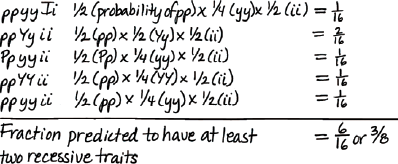
Redraw the Punnett square on the right side of Figure 11.8 as two smaller monohybrid Punnett squares, one for each gene. Below each square, list the fractions of each phenotype produced. Use the rule of multiplication to compute the overall fraction of each possible dihybrid phenotype. What is the phenotypic ratio?

%%Concept 11.3: Inheritance patterns are often more complex than predicted by simple Mendelian genetics%%
Extensions of Mendelian genetics for a single gene:
Extensions of Mendelian genetics for two or more genes:
The expression of a genotype can be affected by environmental influences. Polygenic characters that are also influenced by the environment are called multifactorial characters.
An organism’s overall phenotype reflects its overall genotype and unique environmental history. Even in more complex inheritance patterns, Mendel’s fundamental laws still apply.
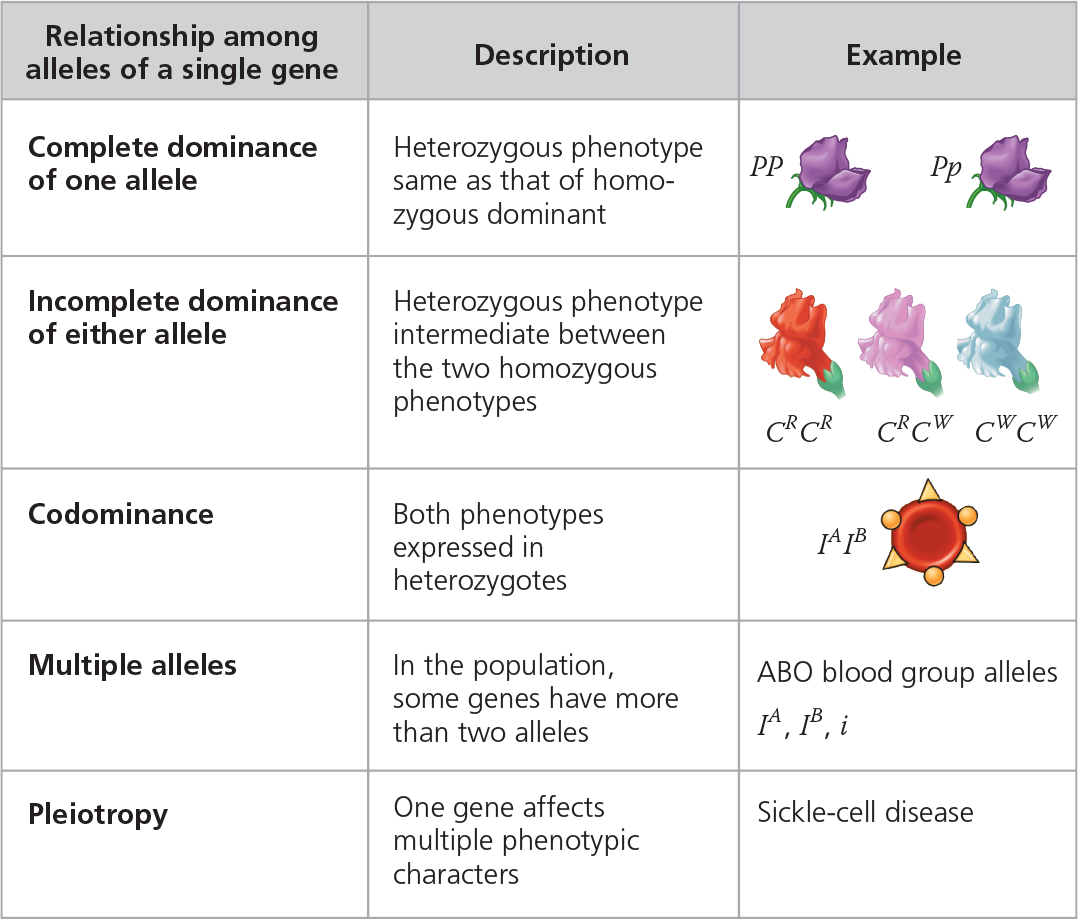
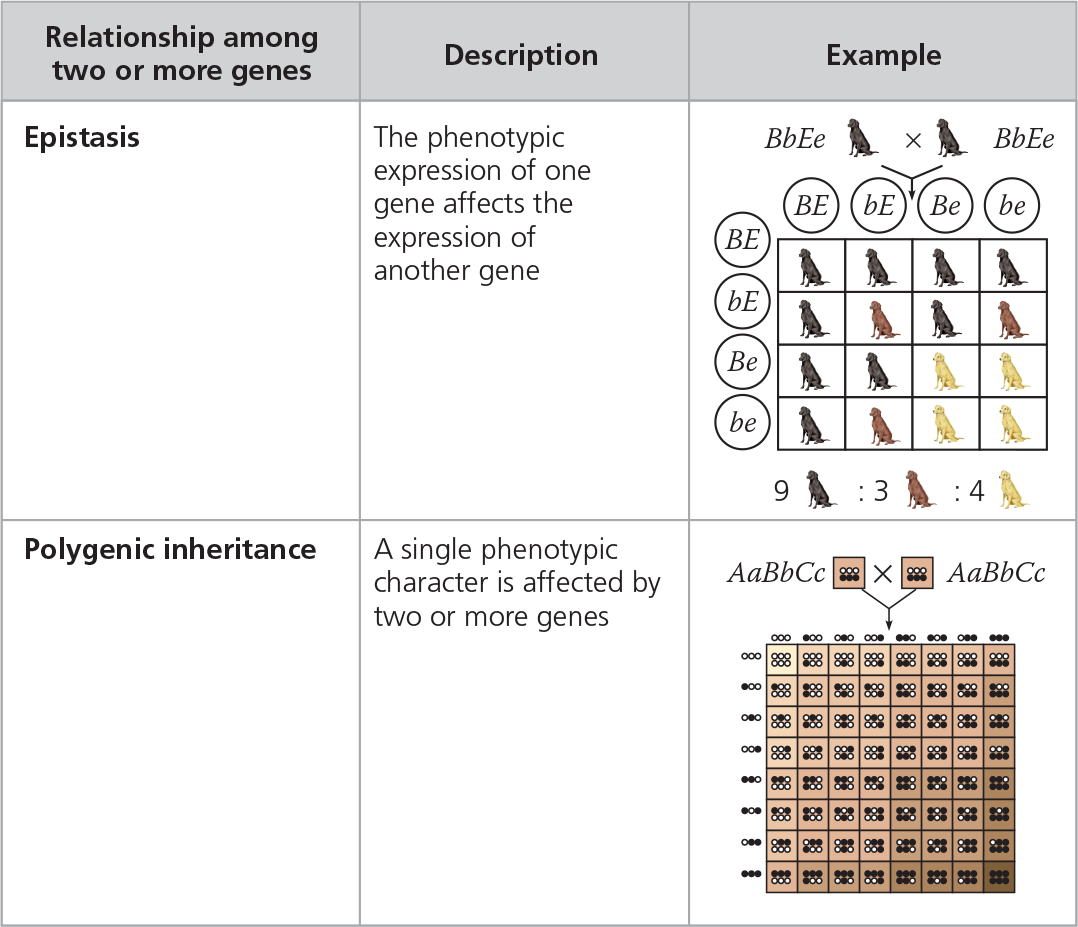
{{Complete Dominance:{{
The situation in which the phenotypes of the heterozygote and dominant homozygotes are indistinguishable
{{Incomplete Dominance:{{
The situation in which the phenotype of heterozygotes is intermediate between the phenotypes of individuals homozygous for either allele
Incomplete dominance in snapdragon color: When red snapdragons are crossed with white ones, the F1 hybrids have pink flowers. Segregation of alleles into gametes of the F1 plants results in an F2 generation with a 1:2:1 ratio for both genotype and phenotype. Neither allele is dominant, so rather than using upper- and lowercase letters, we use the letter C with a superscript to indicate an allele for flower color: C R for red and C W for white

Suppose a classmate argues that this figure supports the blending hypothesis for inheritance. What might your classmate say, and how would you respond?
Your classmate would probably point out that the F1 generation hybrids show an intermediate phenotype between those of the homozygous parents, which supports the blending hypothesis. You could respond that crossing the F1 hybrids results in the reappearance of the white phenotype, rather than identical pink offspring, which fails to support the idea of traits blending during inheritance, in which case the white trait would have been lost after the F1 generation
{{Codominance:{{
The situation in which the phenotypes of both alleles are exhibited in the heterozygote because both alleles affect the phenotype in separate, distinguishable ways
It is important to understand that an allele is called ___ because it is seen in the phenotype, not because it somehow subdues a recessive allele
- dominant
{{Tav-Sachs Disease:{{
A human genetic disease caused by a recessive allele for a dysfunctional enzyme, leading to the accumulation of certain lipids in the brain. Seizures, blindness, and degeneration of motor and mental performances usually become manifest a few months after birth, followed by death within a few years
At the ___ level, the Tay-Sachs allele qualifies as recessive
- organismal
The intermediate phenotype observed at the ___ level is characteristic of incomplete dominance of either allele
- biochemical
Multiple alleles for the ABO blood groups: The four blood groups result from different combinations of three alleles
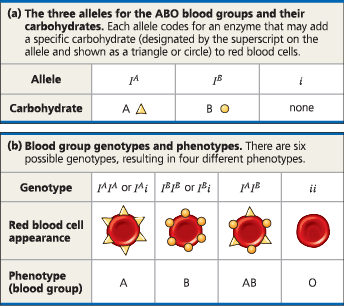
Based on the surface carbohydrate phenotype in (b), what are the dominance relationships among the alleles?
Both the IA and IB alleles are dominant to the i allele, which is recessive and results in no attached carbohydrate. The IA and IB alleles are codominant; both are expressed in the phenotype of IAIB heterozygotes, who have type AB blood
{{Pleiotropy:{{
The ability of a single gene to have multiple effects
{{Epistasis:{{
A type of gene interaction in which the phenotypic expression of one gene alters that of another independently inherited gene
An example of epistasis: This Punnett square illustrates the genotypes and phenotypes predicted for offspring of matings between two black Labrador retrievers of genotype BbEe. The E/e gene, which is epistatic to the B/b gene coding for hair pigment, controls whether or not the pigment of any color will be deposited in the hair

{{Quantitative Character:{{
A heritable feature that varies continuously over a range rather than in an either-or fashion
{{Polygenic Inheritance:{{
An additive effect of two or more genes on a single phenotypic character
Height is a good example of ___: Genomic studies have identified at least 180 gene variations that affect height
- polygenic inheritance
A simplified model for polygenic inheritance of skin color: In this model, three separately inherited genes affect skin color. The heterozygous individuals (AaBbCc) represented by the two rectangles at the top of this figure each carry three dark-skin alleles (black circles, representing A, B, or C) and three light-skin alleles (white circles, representing a, b, or c). The Punnett square shows all the possible genetic combinations in gametes and offspring of many hypothetical matings between these heterozygotes. The results are summarized by the phenotypic frequencies (fractions) under the Punnett square. (The phenotypic ratio of the skin colors shown in the boxes is 1:6:15:20:15:6:1.)

{{Multifactorial:{{
Referring to a phenotypic character that is influenced by multiple genes and environmental factors
Incomplete dominance and epistasis are both terms that define genetic relationships. What is the most basic distinction between these terms?
Incomplete dominance describes the relationship between two alleles of a single gene, whereas epistasis relates to the genetic relationship between two genes (and the respective alleles of each).
If a man with type AB blood marries a woman with type O, what blood types would you expect in their children? What fraction would you expect of each type?
Half of the children would be expected to have type A blood and half type B blood.
A rooster with gray feathers and a hen of the same phenotype produce 15 gray, 6 black, and 8 white chicks. What is the simplest explanation for the inheritance of these colors in chickens? What phenotypes would you expect in the offspring of a cross between a gray rooster and a black hen?
The black and white alleles are incompletely dominant, with heterozygotes being gray in color. A cross between a gray rooster and a black hen should yield approximately equal numbers of gray and black offspring.
Which genetic relationships listed in the first column of the two tables are demonstrated by the inheritance pattern of the ABO blood group alleles? For each genetic relationship, explain why this inheritance pattern is or is not an example
The ABO blood group is an example of multiple alleles because this single gene has more than two alleles (I A, I B, and i). Two of the alleles, I A and I B, exhibit codominance, since both carbohydrates (A and B) are present when these two alleles exist together in a genotype. I A and I B each exhibit complete dominance over the i allele. This situation is not an example of incomplete dominance because each allele affects the phenotype in a distinguishable way, so the result is not intermediate between the two phenotypes. Because this situation involves a single gene, it is not an example of epistasis or polygenic inheritance
%%Concept 11.4: Many human traits follow Mendelian patterns of inheritance%%
Analysis of family pedigrees can be used to deduce the possible genotypes of individuals and make predictions about future offspring. Such predictions are statistical probabilities rather than certainties

Many genetic disorders are inherited as simple recessive traits. Most affected (homozygous recessive) individuals are children of phenotypically normal, heterozygous carriers
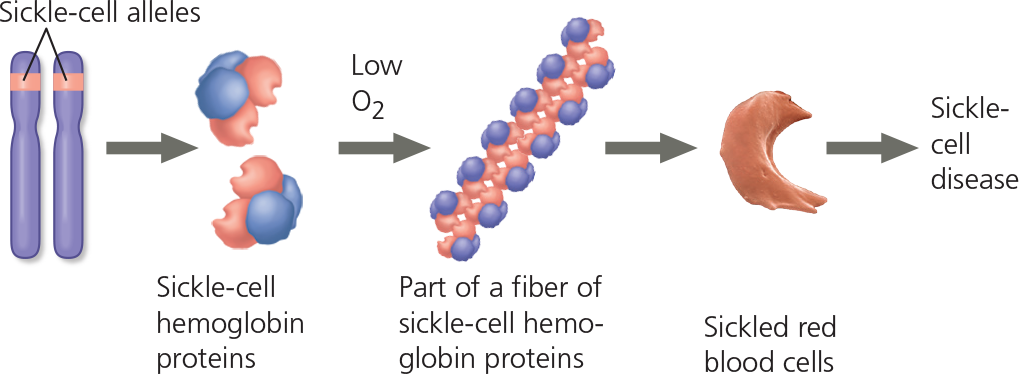
The sickle-cell allele has probably persisted for evolutionary reasons: Heterozygotes have an advantage because one copy of the sickle-cell allele reduces both the frequency and severity of malaria attacks
Lethal dominant alleles are eliminated from the population if affected people die before reproducing. Nonlethal dominant alleles and lethal alleles that are expressed relatively late in life are inherited in a Mendelian way
Many human diseases are multifactorial—that is, they have both genetic and environmental components and do not follow simple Mendelian inheritance patterns
Using family histories, genetic counselors help couples determine the probability of their children having genetic disorders
{{Pedigree%%:%%{{
A diagram of a family tree with conventional symbols, showing the occurrence of heritable characters in parents and offspring over multiple generations
Pedigree analysis: Each pedigree traces a trait through three generations of the same family. The two traits have different inheritance patterns. For the sake of understanding genetic principles, each trait is shown as being determined by two alleles of a single gene. This is a simplification because other genes may also affect each of these characters

The two grandparents with widow’s peaks must have the ___ genotype since some of their offspring are homozygous recessive
- Ww
Suppose that the couple represented in the second generation of Figure 11.14 decides to have one more child. What is the chance the child will have a widow’s peak and be unable to taste PTC?
Assuming that the genes for these two characters are on different chromosomes, the two pairs of alleles will assort independently in this dihybrid cross (WwTt × WwTt). Thus, we can use the multiplication rule: ¾ (chance of widow’s peak) × ¼ (chance of inability to taste PTC) = 3∕16 (chance of widow’s peak and inability to taste PTC)
{{Carrier:{{
In genetics, an individual who is heterozygous at a given genetic locus for a recessively inherited disorder. The heterozygote is generally phenotypically normal for the disorder but can pass on the recessive allele to offspring
Albinism: One of the two sisters shown here has normal coloration; the other has albinism. Most recessive homozygotes are born to parents who are carriers of the disorder but themselves have a normal phenotype, the case shown in the Punnett square

What is the probability that the sister with a normal coloration is a carrier of the albinism allele?
In the Punnett square, two of the three individuals with normal coloration are carriers, so the probability is ⅔. (Note that you must take into account everything you know when you calculate probability: You know she is not aa, so there are only three possible genotypes to consider.)
{{Consanguineous:{{
Same blood
People with recent common ancestors are ___ to carry the same recessive alleles than unrelated people
- more likely
{{Cystic Fibrosis:{{
A human genetic disorder caused by a recessive allele for a chloride channel protein; characterized by excessive secretion of mucus and consequent vulnerability to infection; fatal if untreated
{{Sickle-Cell Disease:{{
A recessively inherited human blood disorder in which a single nucleotide change in the beta-globin gene causes hemoglobin to aggregate, changing red blood cell shape and causing multiple symptoms in afflicted individuals
Although two sickle-cell alleles are necessary for an individual to manifest full-blown sickle-cell disease, the presence of one sickle-cell allele can affect the ___
- phenotype
Sickle-cell disease and sickle-cell trait

Why haven’t evolutionary processes resulted in the disappearance of the allele among this population?
Having a single copy of the sickle-cell allele reduces the frequency and severity of malaria attacks
{{Achondroplasia:{{
A form of dwarfism that is dominantly inherited
Achondroplasia as a dominant trait: Dr. Michael C. Ain has achondroplasia, a form of dwarfism caused by a dominant allele. This has inspired his work: He is a specialist in the repair of bone defects caused by achondroplasia and other disorders. The dominant allele (D) might have arisen as a mutation in the egg or sperm of a parent or could have been inherited from an affected parent, as shown for an affected father in the Punnett square

A lethal recessive allele is only lethal when ___; it can be passed from one generation to the next by heterozygous carriers because the carriers themselves have normal phenotypes
- homozygous
A lethal dominant allele often causes ___, and in this case, the allele is not passed on to future generations
- the death of afflicted individuals before they can mature and reproduce
{{Huntington’s Disease:{{
A human genetic disease caused by a dominant allele; characterized by uncontrollable body movements and degeneration of the nervous system; usually fatal 10 to 20 years after the onset of symptoms
The hereditary diseases we have discussed so far are sometimes described as simple Mendelian disorders because they result from ___
- abnormality of one or both alleles at a single genetic locus
Beth and Tom each have a sibling with cystic fibrosis, but neither Beth nor Tom nor any of their parents have the disease. Calculate the probability that if this couple has a child, the child will have cystic fibrosis. What would be the probability if a test revealed that Tom is a carrier but Beth is not?
½ (Since cystic fibrosis is caused by a recessive allele, Beth and Tom’s siblings who have CF must be homozygous recessive. Therefore, each parent must be a carrier of the recessive allele. Since neither Beth nor Tom has CF, this means they each have a ⅔ chance of being a carrier. If they are both carriers, there is a ¼ chance that they will have a child with CF. ⅔ × ⅔ × ¼ = ¹/₉); 0 (Both Beth and Tom would have to be carriers to produce a child with the disease.)
In Table 11.1, note the phenotypic ratio of the dominant to recessive trait in the F2 generation for the monohybrid cross involving flower color. Then determine the phenotypic ratio for the offspring of the second-generation couple in Figure 11.14b. What accounts for the difference in the two ratios?
In the monohybrid cross involving flower color, the ratio is 3.15 purple : 1 white, while in the human family in the pedigree, the ratio in the third generation is 1 can taste PTC : 1 cannot taste PTC. The difference is due to the small sample size (two offspring) in the human family. If the secondgeneration couple in this pedigree were able to have 929 offspring as in the pea plant cross, the ratio would likely be closer to 3:1. (Note that none of the pea plant crosses in Table 11.1 yielded exactly a 3:1 ratio.)
Both members of a couple know that they are carriers of the cystic fibrosis allele. None of their three children has cystic fibrosis, but any one of them might be a carrier. The couple would like to have a fourth child but are worried that he or she would very likely have the disease, since the first three do not. What would you tell the couple? Would it remove some more uncertainty in their prediction if they could find out whether the three children are carriers?
The chance of the fourth child having cystic fibrosis is ., as it was for each of the other children, because each birth is an independent event. We already know that both parents are carriers, so whether their first three children are carriers or not has no bearing on the probability that their next child will have the disease. The parents’ genotypes provide the only relevant information